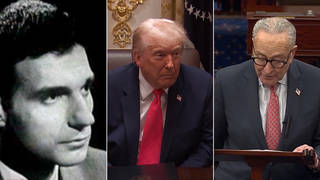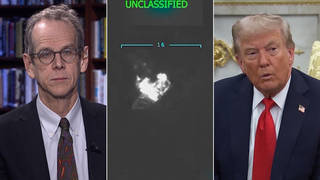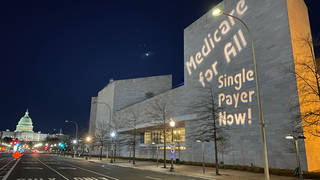
Guests
- Peter Hotezco-director of the Center for Vaccine Development at Texas Children’s Hospital and dean of the National School of Tropical Medicine at Baylor College of Medicine.
The Biden administration has vowed to increase the rate of vaccinations as COVID-19 continues to spread uncontrollably across the entire U.S., with 90,000 people predicted to die in the next four weeks. President Biden announced plans to acquire another 200 million doses of COVID-19 vaccines made by Moderna and Pfizer-BioNTech and is devising ways to allow retired nurses and doctors to administer vaccines. Dr. Peter Hotez, co-director of the Center for Vaccine Development at Texas Children’s Hospital and dean of the National School of Tropical Medicine at Baylor College of Medicine, says the Trump administration’s lies and inaction around the pandemic laid the groundwork for the current explosion in cases. He also warns that a “globalized anti-science movement” has grown stronger in recent years, spreading dangerous disinformation and threatening the public health response to COVID-19. “It’s a killer, because now people are tying their political allegiance to not getting vaccinated, to not wearing marks, to not social distancing.”
Transcript
AMY GOODMAN: Another 4,000 people died in the United States from COVID-19 over the past day in what’s been the deadliest month since the pandemic began. The Biden administration projects as many as 90,000 more people will die in the next four weeks as the virus spreads uncontrollably across the United States. The total number of recorded COVID deaths in North and South America has just topped a million — nearly half the world’s total. And that actual death toll is believed to be even higher.
On Wednesday, the Biden White House vowed to take more steps to increase the rate of vaccinations, after the Trump administration left behind no national vaccination plan. Biden’s coronavirus adviser, Andy Slavitt, said it will take months before many people are vaccinated.
ANDY SLAVITT: We are taking action to increase supply and increase capacity. But even so, it will be months before everyone who wants a vaccine will be able to get one.
AMY GOODMAN: To help speed up the effort, the Biden administration is devising ways to allow retired nurses and doctors to administer vaccines. Earlier this week, Biden announced plans to acquire another 200 million doses of COVID-19 vaccines made by Moderna and Pfizer-BioNTech.
The race to vaccinate the nation comes as more infectious — and possibly more deadly — variants of the virus are spreading across the globe, including variants originating in the United Kingdom, Brazil and South Africa. On Wednesday, the Biden administration admitted the United States is far behind many other countries in genetic sequencing to track the different variants. By one ranking, the U.S. is 43rd in the world.
We now go to Houston, Texas, where we’re joined by Dr. Peter Hotez. He’s co-director of the Center for Vaccine Development at Texas Children’s Hospital and dean of the National School of Tropical Medicine at Baylor College of Medicine. Dr. Hotez is the author of the forthcoming Preventing the Next Pandemic: Vaccine Diplomacy in a Time of Anti-science.
Dr. Hotez, thanks so much for joining us. If you can explain right now the new approach that the Biden administration is taking here in the United States, the wealthiest country in the world, yet we have more than a fifth of the world’s deaths and more than a fifth of the world’s infections, with less than 5% of the population? What is happening? And why is the rollout so problematic, where about half — what? — 20 of 40 million vaccines are not accounted for?
DR. PETER HOTEZ: Yeah. You know, we’ve had huge issues around COVID-19 containment and control all through 2020. And there were two pieces to that, mostly coming out of the Trump White House. There was this insistence, number one, on not having the federal government in the lead, having the individual states take the leadership, with the federal government providing the backup support for supply chain management and that sort of thing. But the states never had the epidemiologic horsepower, didn’t have the modeling, didn’t have the knowledge base to really know how to contain this virus. And so that was a failed strategy.
And then you had, over the summer, or late spring, early summer, this concerted disinformation campaign coming from the White House to downplay the severity of the epidemic, dismiss masks as being an important public health control tool, spectacularizing hydroxychloroquine, which really had no impact. And all of those combined led to this steep acceleration that we saw in the summer in the Southern states, then in the Midwest in the fall.
And then, with the National Vaccine Program, there really wasn’t much of a national vaccine program. There was Operation Warp Speed, which was a development program for new vaccines, but then there were no real logistics for getting it out to individuals to be vaccinated. The logistics were about putting the boxes on the backs of the FedEx and UPS trucks and delivering them to the states without any national plan.
So, this is what the Biden administration has inherited. And now it’s a matter of trying to catch up as rapidly as possible and actually create a program for vaccinating the American people. And it’s tough, because we have a very depleted health system that’s overly reliant on the pharmacy chains and the hospital chains. It’s not a health system as we would know it with a carefully orchestrated system of community clinics and that sort of thing.
So, we’ve got a lot of work ahead of us, and we’re not doing well. We’ve only vaccinated about 5 or 6% of the American population. We need to get to about 75% before we interrupt transmission. And we have to do it soon, with all the new variants coming in. And so, now there’s a race against the new variants. And I think that means we have to vaccinate around 3 million Americans a day to get those half a billion immunizations — 240 million people times two doses each — over the next few months. And it doesn’t look like we’re going to be able to get there, either.
NERMEEN SHAIKH: Dr. Hotez, could you talk about — you’ve written about this problem, of course, in a Washington Post — a recent Washington Post article. What will happen, if the scenario that you’re suggesting is essential, namely, 500 million — that’s half a billion — vaccines in the next five months — if those are not given in the next five months, what do you see happening in the U.S., in particular, given the new variants that have surfaced?
DR. PETER HOTEZ: Well, the bottom line is, the deaths will increase. Our Centers for Disease Control estimates that the new U.K. variant, for instance, could become a dominant variant in the U.S. as early as the spring. And we also have the Brazilian variant here. As far as we know, we don’t have the South African variant here. But, you know, we’re not really looking. As you pointed out, we rank near the bottom of doing genomic sequencing of viruses, even though we have the world’s largest capacity for doing genomic sequencing. So, again, there’s been this disconnect between the science, our scientific horsepower and our public health response. And hopefully we can begin correcting that in the new administration.
So, the numbers are chilling. We’ll get to 500,000 Americans who will lose their lives, and get to 600,000. And the reason I wrote the piece in The Washington Post was to kind of remind not only the Biden administration, but the American people, that we don’t have to get there. We just need to do some levers, in terms of pulling and pushing, in order to get the population vaccinated quicker. And I think part of that relies on not being so reliant on the mRNA vaccines, that tend to be a fussy technology in terms of scale-up and production, and bringing on some of the other vaccines, including the AstraZeneca-Oxford vaccine, which we think may be approved by the European Union tomorrow, and if we could do the same in the United States, get the J&J adenovirus vaccine. And, you know, we have a recombinant protein COVID vaccine that’s now being produced in India. They have the capacity for producing 1.2 billion doses. And no one from the federal government has approached us about bringing that vaccine into the U.S.
So I think there are many more things that we can do to get the population vaccinated faster. And it was a tough op-ed to write, because, you know, the Biden administration gets it. They’re science- and evidence-based. They’re trying to — they’ve got good people in place. They’ve inherited a mess. And so, you don’t — a week into their term, it’s not really fun to say, “Yes, but you’ve got to do more. Here’s what I suggest.” But, you know, when it comes to saving lives, sometimes you have to do those things.
NERMEEN SHAIKH: Well, Dr. Hotez, in addition to all of the logistical problems that you’ve outlined in administering the vaccines here in the U.S., and also, of course, around the world, you’ve written about the rise of strong anti-science aggression in the U.S. If you could talk about that and the fact that the World Health Organization has listed a vaccine hesitancy as one of the top 10 threats to global health, and a recent Kaiser Foundation poll — in December, that is — that found that 25% of Americans say they will probably or definitely not take the vaccine, even once it becomes available to them?
DR. PETER HOTEZ: Yeah. In fact, we’ve also published a similar paper. I was part of it, but it was led by a group of social scientists at Texas A&M University in the School of Public Health. And both the Kaiser survey and our survey found the same thing, that there are two very different groups that are highly vaccine hesitant in the U.S. when it comes to COVID-19 vaccines. One are what we call Trump voters, what the Kaiser survey called Republicans, but same idea of people from the political right. And then add the African American population. If you think about it, wow, what two very disparate types of populations that are meeting around vaccine hesitancy.
So, trying to understand that, I think with the — in terms of the political right, this is a movement that we saw building up in 2015 around the time of the Trump election. It really took off where I am, in Texas, with the formation of organizations like Texans for Vaccine Choice, Oklahomans for Vaccine Choice. This came out of a new health freedom or medical freedom ideology that government can’t tell us what to do. And then, starting in 2020, those same anti-vaccine groups glommed on protests against masks and social distancing. And this is when you had national anti-vaccine groups form. And then this globalized to Western Europe last year, and there were anti-mask, anti-vaccine protests linked to QAnon and the same kind of health freedom ideology. And these protests were in Trafalgar Square in London, in Berlin, in Paris. So, this is now a full-on, globalized anti-science movement.
And today we’re releasing a paper that will come out in PLOS Biology, the Public Library of Science, PLOS Biology, really looking at the historical thread of this anti-science movement. And it’s a killer, right? Because now people are tying their political allegiance to not getting vaccinated, to not wearing masks, to not social distancing. And this was promoted by the White House through their disinformation campaign last year. And on top of that, you have the Russian government flooding our internet with what’s been termed “weaponized health communication” through their bots and trolls. So, looking at this, what was a kind of a fringe group has now blossomed in a terrible way to a full-on anti-science confederacy or empire. And we have to figure out ways to counteract that. So I go through the historical thread of that in this PLOS Biology paper.
AMY GOODMAN: Dr. Hotez, I wanted to ask you about what’s happening in your state, in Texas, in Dallas County, which has reversed the plan to prioritize vaccinating people in its hardest-hit areas, largely communities of color, after state authorities threatened to cut their supply, saying it didn’t meet official distribution guidelines — your hard-right governor, Governor Abbott, being involved with this. Can you explain what’s happened here?
DR. PETER HOTEZ: No, I can’t. You know, we know that COVID-19 is a health disparity, and we’ve seen it hit especially hard among our Hispanic populations. Those are the groups getting really decimated because of the essential nature of their work. They’re not working at home via Zoom and Skype. They’re on construction sites, in family-owned businesses, in multigenerational homes, so the 22-year-old kid on the construction site is bringing it home to his parents and his grandparents. And I testified to the Congressional Hispanic Caucus last year and called this historic decimation of the Hispanic communities in Texas.
And then you have this group on the far right which is protesting against masks and contact tracing and social distancing and now vaccines. And so, this is a very lethal and toxic mix that we have in Texas, and that’s why Texas is a leader, in a negative way, in terms of number of deaths. And this is one of the reasons that we’re here, you know, not only being a vaccine scientist, but trying to go up against these anti-vaccine, anti-science groups. I have a daughter with autism, and I wrote a book a few years ago called Vaccines Did Not Cause Rachel’s Autism. And that’s put me front and center of this, having to confront and launch this counteroffensive to the anti-science groups. It’s not fun. It’s a scary place to be, but really necessary, as well. And this may be a new role that scientists in America have to have, which is to combat anti-science as part of their activities.
AMY GOODMAN: You’re one of the officials at Texas Children’s Hospital. When we talk about these vaccines going into the arms of hundreds of millions of people, we’re talking about over 16. The desperate plight to get kids back to school, the increase in suicide in places. What about tests on kids? Are you involved with them? Where are they happening? How do they happen? How do parents say, “You can test my kid”?
DR. PETER HOTEZ: Yeah, I don’t have too many details about that. One of the things that I’ve been pushing hard for, though, is the fact that if we’re going to reach 240 million Americans to vaccinate, we’re going to have to include adolescents and children in that mix. And so, accelerating vaccines for adolescents and kids also has to be a priority. And those clinical trials have not begun with the mRNA vaccine and, I believe, the adenovirus vaccines, as well. And that’s something we’re going to look at.
One of the things that we’re pretty excited about with our recombinant protein vaccine is it uses a 35-year-old technology, recombinant protein expression through microbial fermentation. And that’s what the hepatitis B vaccine is right now. And that’s been used to vaccinate kids for over 35 years. It’s very a safe, old-school vaccine technology, and we think this could be really advantageous for our COVID vaccine for kids, as well.
NERMEEN SHAIKH: Dr. Hotez, just to go back to your earlier point, you’ve written, of course, a whole book, as you mentioned, about your daughter’s own experience with autism. If you could say what some of the misinformation is that’s circulating about this vaccine, about these vaccines, the COVID vaccines? You’ve written, for example, that some of the concerns around the allergic reactions to the vaccines are not necessarily that different from allergic reactions that you see to other very common vaccines, including the flu vaccine. What do you think some of the misinformation is that’s going around, and how can it be counteracted?
DR. PETER HOTEZ: Yeah, and this is a huge problem, because the anti-vaccine groups now, which historically have gone after the measles-mumps-rubella vaccine in kids or the HPV vaccine for cervical cancer and other cancers, have done a lot of damage in terms of getting parents not to vaccinate their kids or adolescents, are now pivoted and turned their attention to COVID-19 vaccines and COVID-19 prevention measures. So, there’s quite a laundry list now of things that they’re alleging. And you sort of play this pyrrhic game of whack-a-mole. You knock one down, another pops up.
So, the first was that these are high rates of allergic reactions that kill. It’s not true. The rate of anaphylaxis in the Pfizer and Moderna vaccine has now been looked at. It’s around three to five per million, which is a little higher than the anaphylaxis rate for flu vaccine or HPV vaccine, which is one to two per million, but it’s still a very rare event, number one.
Number two, they’re saying vaccines were rushed; you know, just they popped up out of nowhere in a few months. It’s not true. This builds on a decade or more of research and development, identifying the spike protein as the soft target of the coronavirus. This is work that we began more than a decade ago, and figuring out ways to deliver the spike protein in a vaccine. So, this has been a program that’s been in play for more than a decade, after the first SARS and MERS serious respiratory syndromes emerged.
Then — you know, then it gets crazier from there: assertions that the mRNA is creating what they term genetically modified humans, GMH. You’ve heard of genetically modified organisms. Now they’re calling them genetically modified humans. You know, they still haven’t learned much in the way of high school biology, not realizing the cell has both a nucleus and cytoplasm, and the mRNA only gets into the cytoplasm, and it gets made into protein. So, debunking that.
And then, again, then it gets crazier from there. There’s a big component saying that we’re implanting microchips into people. And it’s got me and Tony Fauci and Bill Gates out in some Area 51 lab sticking microchips into the vaccines and 5G links, and you can imagine, and saying the vaccines contain aborted fetuses or aborted fetus material.
All of that needs to be defused. And part of the problem is, you know, in the United States, we’ve never really mounted a big counteroffensive against the anti-vaccine disinformation campaign. We focus a lot on amplifying pro-vaccine messages when we can, but we’ve never taken a serious effort to dismantle the empire. And I think that’s something that we’re going to have to look at, if we’re going to be successful at this.
NERMEEN SHAIKH: And, Dr. Hotez, finally, your forthcoming book is titled Preventing the Next Pandemic: Vaccine Diplomacy in a Time of Anti-science. Explain what you mean by “vaccine diplomacy.” And also, this fact, which you were just talking about, of anti-science, where does this originate? I mean, you’ve said that these anti-vaxxers are opportunists, but what do anti-vaxxers stand to gain from opposing the vaccines that might in fact save them?
DR. PETER HOTEZ: Well, the book looks at a lot of 21st century forces that are bringing back disease. And I actually started writing it about a year before COVID-19. And it looks at things like war and political collapse, depleting health systems, climate change, urbanization. And one of the subthemes of the book is the fact that all of these things are not ordinarily areas that biomedical scientists get training in, and that we have — it’s a call to broaden our training for biomedical scientists.
In terms of the anti-science movement, it really, I think, really amplified in Texas starting in 2015. And I think one of the ways it got so strong was the link to political funding and the creation of political action committees. So, part of the motivation is that the anti-science groups tied their star to the far-right wing of the Republican Party in the United States and that that had an amplifying effect.
But it’s not the only thing going on. There’s also a link between a very expansive health and wellness industry that’s promoting fake nutritional supplements, even fake autism cures. So that’s another thread. You also — and also the fake books. If you go to Amazon.com and, as everyone has done, put “books” up at the top, press return, you’ll get a scroll-down menu to the left that includes health, fitness and diet. And you click on that, you’ll get a second menu that says “vaccinations.” It’s all fake anti-vaccine COVID conspiracy books. So, Amazon is probably one of the single largest promoter of anti-science and anti-vaccine disinformation.
So, a lot of this is monetizing the — monetizing anti-science, monetizing the internet. And that’s a big driver, as well. So, we don’t really have our arms around the full money trail, by any means, and I think that would also be a very productive avenue for some investigative journalist to look at.
AMY GOODMAN: Dr. Peter Hotez, we want to thank you so much for being with us, co-director of the Center for Vaccine Development at Texas Children’s Hospital and dean of the National School of Tropical Medicine at Baylor College of Medicine, author of the forthcoming book, Preventing the Next Pandemic: Vaccine Diplomacy in a Time of Anti-science, speaking to us from Houston, Texas.
When we come back, no matter how difficult it is to get vaccines in the United States, compare it to scores of poorer countries around the world. Stay with us.











Media Options